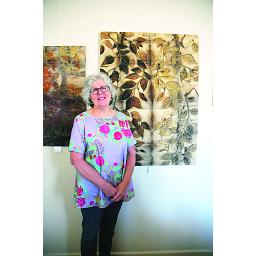Heidi Kraak
A love of experimenting and learning is what drives Joan Best’s artistic practice.
Retirement has helped, too.
“I can go down and get some leaves from here or there, or nick down to the park,” she said.
“I find leaves from all over the place and try different things.”
Beginning her working life as a high school art teacher, Ms Best is no stranger to learning on the go.
Despite challenging her university at the time to allow women to study metalwork, Ms Best was not permitted to study it because she was too far along in her studies – her first job, ironically, required her to teach metal work.
“I was having to go to classes myself. I was about a week ahead of the kids in my class,” she said.
After tiring of teaching, Ms Best went back and studied nursing, eventually becoming a mental health nurse until retiring, and fills her now-unoccupied time experimenting with natural dyes using leaves and printing.
Having taken bits and pieces of expertise from classes, classmates and people she has met along the way, Ms Best has developed her own method of creating prints by extracting colour from leaves.
Able to achieve “enormous variation and colour”, Ms Best’s process involves “mercilessly squishing” the leaves and material between wooden blocks with clamps and, after removing the clamps, “chucking it” in the crockpot or bath and letting it “do its own thing”.
“The heat and the pressure force the colour to come out of the leaves and onto the wool,” she said.
Her final pieces, which are on display at the Yarragon Station Gallery through February, are a combination of her unique printing method, machine and hand embroidery.











